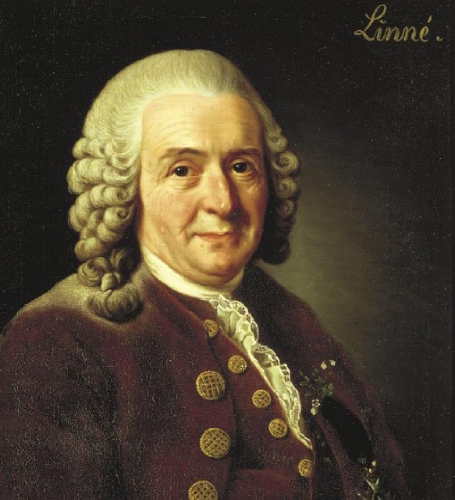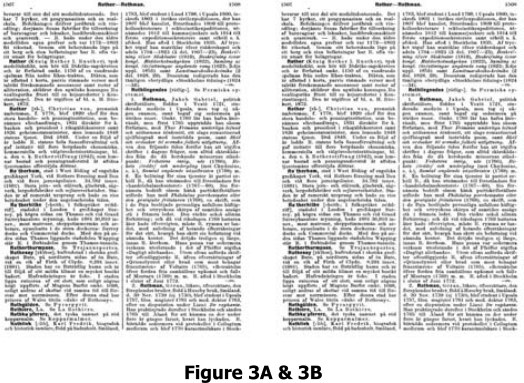Background
Carl Linnaeus (1707–1778) is probably the best-known Swede worldwide (Figure 1). His contributions to systematic botany presented in his “Systema Naturae” and “Species Plantarum” (Figure 2) gained him a great reputation.
Figure 1.
The colour portrait of Linnaeus owned by and is on display at the Swedish Academy of Science, Stokholm, Sweden
Figure 2.
The cover pages of Linnaeus famous two books representing the basis of modern Botany and Taxonomy.
He enthused his students so much that 23 of them became professors in various centres of excellence of their time. Linnaeus was indeed responsible for sending some of his adventurous students to distant lands recording and collecting. He often described these scholars as his "Apostles". Göran Rothman, the subject of this work, was one of the four Apostoles who came to North Africa and the Middle East. The aim of this paper is to put together all fragmented pieces of work that are available on Rothman's Life and Work, and present a first-hand English translation of some of the original Swedish documents with a view of stimulating further work.
His life and education
Göran Rothman was born in Skatelöv (province of Småland) on November 30, 1739. His father was Dr Johan Rothman (1684–1763). Goran was the older half-brother from his father's late marriage to Anna Elisabeth Rudebeck. His father, a physician and botanist, studied at Harderwijk and Leiden. Göran Rothman went to Uppsala for his studies in 1757. He graduated with a Master in Philosophy in 1761, and two years later graduated as a medical doctor after defending his dissertation on De Raphania under the supervision of Carl Linnaeus on 27 May 1763. Thereafter, he settled in Stockholm as a practicing physician between 1763 and 1765. In 1765, he was sent to the island of Åland (Now in Finland) to help control the plague which has been there for several years. After spending a period of time as a member of the faculty in the College of Medicine, he was appointed as the supervisor for quarantines in Stockholm archipelago in 1770. Between 1773 and 1776, He made a trip to Tripoli. After his return from Libya, he practiced medicine and teaching for two years and died in Stockholm on December 3, 1778 at the very young age of 39. Linnaeus and Voltaire died in the same year (Figure 3A &B).
Figure 3.
3A above &3B below are scanned pages from the Swedish biography list and Swedish family names book. Some of these were translated into English for the first time in this article (electronically using Google translate online and verified by Dr Sameer Al-Sadawi, of SKMC, Abu Dhabi, UAE)
His work
Göran Rothman became a physician, botanist, translator and author. Unfortunately, he is amongst the least known apostles of Linnaeus. Rothman defended his dissertation on “De Raphania” on 27th May 1763 (Figure 4). A botanico-medical treatise on the disease Raphania (ergotism), recognized by Linnaeus to result from eating bread from freshly harvested grain and erroneously ascribed to the presence of seed of the weed Raphanus raphanistrum L.; common radish (Figure 5).
Figure 4.
The cover page of Goran Rothman's dissertation and the illustration of the plant subject of the dissertation. From the website of The Hunt Institute for Botanical Documentation. Carnegie Mellon University, Pittsburgh, Pennsylvania, USA.
Figure 5.
The figure of Raphanus raphanistrum from Goran Rothman's thesis.
In 1770, whilst working as the supervisor for quarantines in Stockholm archipelago and residing in Stockholm, Abderhman- the envoy of Tripoli in Sweden- promised Rothman all possible support if he would accompany him on a travel to Africa. This idea was taken up by the Swedish Academy of Science who drew the proposals for this journey and promised to make a contribution towards the costs of this journey provided that he travels to visit North Africa and inner Africa to carry out studies and bring collections of local plants. Rothaman started his journey in 1773 accompanied by Abderhman. This would have been during the first Al-Qaramanli dynasty who ruled from 1711 to 1835 in Tripolitania. The dates of his visit would coincide with the reign of Ali Pasha I who reined from 1754–1793. However, the promised financial support from both Abderhaman and the Swedish Academy of Science did not materialize to the extent that Rothman had to start thinking about returning back to Sweden shortly after his arrival in Tripoli.
“The expedition was apparently not the idea of Linnaeus, but had been requested by an envoy in that region. The expedition was far from successful, and although not himself directly at fault for its failure, Rothman suffered misery for the remainder of his life. He died in Stockholm two years later on 4.12.1778.” He spent the last two years as a teacher in the college of medicine and practicing physician.
As a fan of literature, he published several successful works and translations. Important translations included Voltaire's classic tale of “Zadig” originally published in 1747. He also translated “Eloisa letters to Belard” poems of the English essayist Alexander Pope (1688–1744). Rothman also translated some work of Ranieri de' Calzabigi (1714–1795) who was an Italian poet and librettist, most famous for his collaboration with the composer Christoph Willibald Gluck (1714–1787) on the reform operas. Rothman translated his opera “Orpheus and Eurydice” which was well received when played in 1757 with music composed by Gluck. He also translated the newer opera “Alcides”. He has written several small pieces of poem and essay for magazines. In addition, he left several unpublished manuscripts and translations. It has been suggested that some of Rothmans work has been attributed wrongly to others. Some of the correspondence from Rothaman about his trip to Africa was published by Gjörwell in his magazine between 1774 and 1776 (probably this was referring to Carl Christoffer Gjörwell (1731–1811) in his magazine “The Swedish Mercury” which can be considered the beginning of Swedish criticism. Little is known about his collections since there are no letters or specimens sent to
Linnaeus who, at that time, was in failing health. It is often stated that “circumstances prevented his work from being as comprehensive as he had hoped” but no information on the obstacle is available yet. His collections and unpublished diary are in Sweden, Bergianska collections, Kungliga Vetenskapsakademien Stockholm “Resa till Tripoli år 1773–1776”.
Rothman's name is remembered by the genus Rothmannia (Figure 6) which was named after him by his friend the Swedish botanist Carl Peter Thunberg (1743–1828) a Swedish naturalist known as "the father of South African botany" and the "Japanese Linnaeus". There is nothing in the literature to indicate why the genus was named after Rothman.
Figure 6.
The photo of the flower from the genus Rothmania named after Goran Rothman by one of his friends perhaps in sympathy with his failed expedition in North Africa
Opportunities for further research
“The Linnaeus Apostles-Global Science & Adventure” project has been underway by the IK Foundation & Company. The publication of a major international series of eight volumes is in motion. All the accounts of the apostles' journeys to every continent will be published here for the first time in English. Volume Four will be of particular interest. It is due in 2008 and will cover Europe, North East and West Africa and the Middle East. Work of Apostles who visited these places including Göran Rothman will be covered. Subtitle 1 is devoted to Göran Rothman's journal and letters on Sweden, Denmark, Tunisia and Libya. The main source for this section is his Journey to Tripoli in 1773 Translated from the Swedish manuscript; Resa till Tripoli år 1773 af G. Rothman. Once published, this first translation into English will be of great value to researchers with an interest in the history of that era.
Acknowledgement
I would like to express gratitude to Dr Nameer Al Saadwai, Consultant Haematologist at Sheikh Khalifa Medical City for his help in translating some of the original text from Swedish to English and verification of the text which was translated electronically. I would like to acknowledge the various web resources used and credits are given as indicated in the references list and/or in the legends of different figures.
References
- 1.Olsen Sven-Erik Sandermann. Bibliographia Discipuli Linnaei: Bibliographies of the 331 pupils of Linnaeus. Copenhagen. 1997 [Google Scholar]
- 2.Howgego Raymond John, Rothmanm Göran. Vol. 1. Sydney, Australia: Hordern House Rare Books; The Encyclopedia of Exploration. (RG page was courtesy of the publisher). [Google Scholar]
- 3.Rothman Göran. Nordisk familjebok 1800-talsutgåvan. (13.Pontin-Ruete /1507–1508) Project Runeberg. at www.runeberg.org/nfam/0760.html accessed on 14 January 2008.
- 4.Rothman Göran. Biographiskt lexicon of ver namnkunnige svenske man. Uppsala, Sweden: 1846. p. 12. [Google Scholar]
- 5.Burius Anders. ‘Göran Rothman’ Svenskt biografiskt lexikon. 1999. http://runeberg.org/sbh/rothmgor.html.accessed on 14.1.2008.
- 6.The International Plant Names Index. 2007. Published on the Internet http://www.ipni.org. accessed 14 January 2008.








